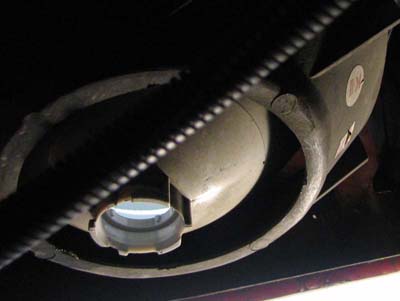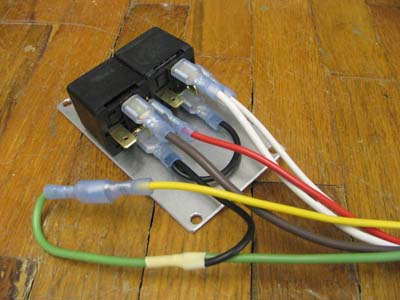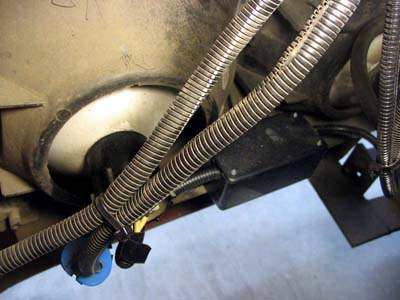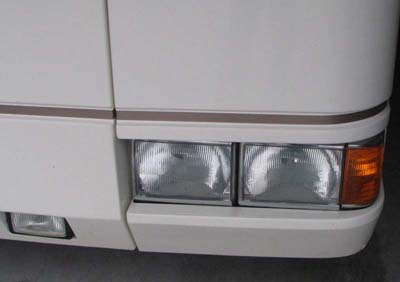Headlight Modifications
As I received it, our Foretravel’s headlights performed very poorly. The first time I drove at night without the benefit of city street lights was in the Ozarks in Arkansas. The road was narrow, winding, and not lined on the right edge. I found it was very hard to safely follow the road with the poor illumination of my lights. When I was able to use high beams, it was much brighter, but still did not extend very far forward. I checked my headlight alignment and found all the lights were set very low. After adjusting them, they were much better, but low beams were still not as bright as I would like or as bright as most of the cars on the road. Finally I decided to do something about it. I did an Internet search and found a number of articles about improving headlights. Even though mine is a 2000 model, it uses headlight assemblies from a 1987 to 1991 Ford Bronco. The typical headlight bulb used then was the 9004, as it is in our rig. The two main changes discussed (other than going to a high intensity discharge or to a Euro type headlight) were to change the bulb to a newer, higher power and better geometry bulb, the 9007, and to add relays to minimize the voltage drop through the various wiring harnesses and switches. The Foretravel is very well engineered and uses heavier gauge wiring and relays (in the passenger compartment). Even with these features, the voltage at the bulbs was over 1 volt lower than the supply voltage. I decided to try both the relays and the change in bulbs. The 9004 and the 9007 are very similar bulbs, but have several differences:
I mounted two relays in a box and wired them to a new lamp socket and a homemade plug made from the base of an old bulb. This allows the relays to be plugged in between the bulb and the old harness without modifying the wiring. One relay controls low beam, and the other the high beam (on the outer headlight only). I made the relay box with an easily changeable connection to accommodate either bulb type. I ran a 10 gauge wire from the headlight breaker to the relay box. I actually made 2 of the relay boxes and used one for the left and one for the right. I decided to do this rather than run multiple wires up over the generator across the front of the rig. I made no change to the inner, high beam lights, as after the re-aiming, the high beams were quite good already and with the improvements to the outer lights, they will only get better. The addition of the relays has increased bulb voltage by 0.7 volts by reducing the voltage loss from supply to headlight to 0.3 volts. The results of these changes are quite remarkable! The illumination
is much brighter, extends farther down the highway, and makes driving on
a dark road quite easy.
Daytime Running Lights I am a proponent of daytime running lights (DRL). I decided to add them to my rig. There are three normal approaches to DRL:
I chose the 2nd approach, as I feel lights that are aimed toward the oncoming driver (high beams), at an intensity low enough to not impair their vision is the most practical. In my case adding dedicated lights would have been impractical. Running at only 40% brightness will have almost no effect on the bulb life, and the electrical consumption is minimal. Of course none of the clearance, tail, or dash lights are on during its use. The Foretravel's inner headlight bulbs are wired for high beam only, and are fed by a separate relay, so there is no direct connection to the outer bulbs. This made these an ideal candidate for the DRL’s. A web search disclosed several aftermarket modules are available.
I decided on a Hamsar unit, as they are makers of many of the OEM modules,
offer a wide selection, and appear to make high quality products.
I chose a model 45035 module, as it is a "high beam, reduced 60%" model
which has an input from the parking brake. It cost about $43.
The module uses pulse width modulation to control the brightness of the
bulb very efficiently. It is over/under voltage, over temperature,
and short circuit protected. In use, the DRL’s are on only when the
ignition is on and the parking brake is off. As soon as I turn on
the normal headlights to either high or low beam, the DRL's are turned
off.
Annunciator The Foretravel has an alarm for just about everything! Almost any over temperature, under pressure, antenna up, or anything-else-you-can-imagine condition sounds an alarm, but there was no alarm for leaving the headlights on! As you might guess, there is now! I have really needed this alarm as I have been using our headlights whenever we travel on a 2 lane road. Many is the time that after stopping at a rest stop or refueling, I would notice the lights were still on. This should be somewhat less of a problem now that the daytime running lights are installed, but I still feel a need for the alarm. I bought a small “chime” unit from Radio Shack for about $10. This is a solid state unit that runs on 6 to 18 volts. I wired it between the clearance light switch contact and a breaker that is hot only when the ignition is on. I wired a diode in series to prevent any reverse voltage problems. Now, whenever the headlights or parking lights are on and the ignition
is off the chime will produce a series of “ding-dong’s” several seconds
apart.
|
||||||||||||||||||
|
Dick Mason, Prescott, AZ 1/9/05
|






